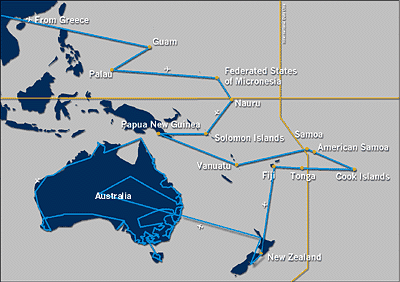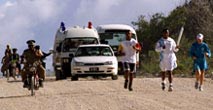
Who
looks after the runners?
When the
longest Torch Relay in Olympic history sets off from Olympia, Greece
on 10 May, it will be followed by a high-tech convoy of vehicles. A
giant jet, a prime mover and a fleet of buses, mini-vans and Harley
Davidson motorcycles are among the support vehicles which assist the
Olympic flame's progress.
Once on Australian soil, 11,000 Torchbearers will carry the flame 27,000 kilometres to its destination inside Stadium Australia. They will be helped by 2500 student escort runners and 47 permanent support vehicles, including police escort motorcycles.
The flame will travel on nearly 50 different kinds of transport during a 100-day journey across the nation. It will be carried across the Nullabor Plain in central Australia by the Indian Pacific train. A scuba diver will carry it underwater at the Great Barrier Reef. It will also be borne by a camel, a surf-lifesaving boat and the Royal Flying Doctor Service.

A lot of planning is needed to make sure the relay goes without a hitch. During the journey:
* 10,400 breakfasts and dinners will be served to the Torch Relay crew
* 3920 bags of crew laundry will be done
* 13,114 beds in 559 hotels have been booked for the crew
* There will a permanent fleet of 47 vehicles, with another 300 vehicles reserved for remote locations. In Oceania, 300 vehicles will be used during the 17-day journey.
* There will be 11,000 torchbearers in Australia, 1500 in Oceania and 800 in Greece.

The Olympic flame will travel in 14 canoes on its way through Oceania. In New Zealand, it will travel on a gondola and visit a bunji-jump site in Queenstown. It will make its way down New Zealand's Coronet Peak via two mountain bikes and two skiers.
Without the use of chartered aircraft, the Olympic flame would not be able to get far around Australia. Therefore, the torch will spend about 27 hours travelling by charter aircraft.